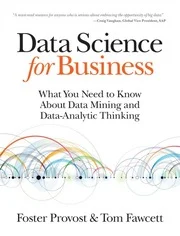
عنوان:
Data science for business
نویسنده:
Fawcett, Tom;Provost, Foster
انتشارات:
O'Reilly
نسخه:
حجم:
19MB
معرفی کتاب: "علم داده برای کسبوکار"
این کتاب بر اساس یک دوره MBA است که Provost در ده سال گذشته در دانشگاه نیویورک تدریس کرده است و نمونههایی از مشکلات واقعی کسبوکار را برای توضیح این اصول ارائه میدهد. شما نهتنها یاد خواهید گرفت که چگونه ارتباط بهتری بین ذینفعان تجاری و دانشمندان داده برقرار کنید، بلکه همچنین خواهید آموخت که چگونه بهطور هوشمندانه در پروژههای علم داده شرکت کنید. همچنین کشف خواهید کرد که چگونه بهطور تحلیلی به دادهها فکر کنید و بهطور کامل درک کنید که روشهای علم داده چگونه میتوانند از تصمیمگیریهای تجاری پشتیبانی کنند.
فهرست مطالب
- Copyright
- Table of Contents
- Preface
- Chapter 1. Introduction: Data-Analytic Thinking
- The Ubiquity of Data Opportunities
- Example: Hurricane Frances
- Example: Predicting Customer Churn
- Data Science, Engineering, and Data-Driven Decision Making
- Data Processing and “Big Data”
- From Big Data 1.0 to Big Data 2.0
- Data and Data Science Capability as a Strategic Asset
- Data-Analytic Thinking
- This Book
- Data Mining and Data Science, Revisited
- Chemistry Is Not About Test Tubes: Data Science Versus the Work of the Data Scientist
- Summary
- Chapter 2. Business Problems and Data Science Solutions
- From Business Problems to Data Mining Tasks
- Supervised Versus Unsupervised Methods
- Data Mining and Its Results
- The Data Mining Process
- Implications for Managing the Data Science Team
- Other Analytics Techniques and Technologies
- Summary
- Chapter 3. Introduction to Predictive Modeling: From Correlation to Supervised Segmentation
- Models, Induction, and Prediction
- Supervised Segmentation
- Visualizing Segmentations
- Trees as Sets of Rules
- Probability Estimation
- Example: Addressing the Churn Problem with Tree Induction
- Summary
- Chapter 4. Fitting a Model to Data
- Classification via Mathematical Functions
- Regression via Mathematical Functions
- Class Probability Estimation and Logistic “Regression”
- Example: Logistic Regression versus Tree Induction
- Nonlinear Functions, Support Vector Machines, and Neural Networks
- Summary
- Chapter 5. Overfitting and Its Avoidance
- Generalization
- Overfitting
- Overfitting Examined
- Example: Overfitting Linear Functions
- Example: Why Is Overfitting Bad?
- From Holdout Evaluation to Cross-Validation
- The Churn Dataset Revisited
- Learning Curves
- Overfitting Avoidance and Complexity Control
- Summary
- Chapter 6. Similarity, Neighbors, and Clusters
- Similarity and Distance
- Nearest-Neighbor Reasoning
- Some Important Technical Details Relating to Similarities and Neighbors
- Clustering
- Stepping Back: Solving a Business Problem Versus Data Exploration
- Summary
- Chapter 7. Decision Analytic Thinking I: What Is a Good Model?
- Evaluating Classifiers
- Generalizing Beyond Classification
- A Key Analytical Framework: Expected Value
- Evaluation, Baseline Performance, and Implications for Investments in Data
- Summary
- Chapter 8. Visualizing Model Performance
- Ranking Instead of Classifying
- Profit Curves
- ROC Graphs and Curves
- The Area Under the ROC Curve (AUC)
- Cumulative Response and Lift Curves
- Example: Performance Analytics for Churn Modeling
- Summary
- Chapter 9. Evidence and Probabilities
- Example: Targeting Online Consumers With Advertisements
- Combining Evidence Probabilistically
- Applying Bayes’ Rule to Data Science
- A Model of Evidence “Lift”
- Example: Evidence Lifts from Facebook “Likes”
- Summary
- Chapter 10. Representing and Mining Text
- Why Text Is Important
- Why Text Is Difficult
- Representation
- Example: Jazz Musicians
- The Relationship of IDF to Entropy
- Beyond Bag of Words
- Example: Mining News Stories to Predict Stock Price Movement
- Summary
- Chapter 11. Decision Analytic Thinking II: Toward Analytical Engineering
- Targeting the Best Prospects for a Charity Mailing
- Our Churn Example Revisited with Even More Sophistication
- Chapter 12. Other Data Science Tasks and Techniques
- Co-occurrences and Associations: Finding Items That Go Together
- Profiling: Finding Typical Behavior
- Link Prediction and Social Recommendation
- Data Reduction, Latent Information, and Movie Recommendation
- Bias, Variance, and Ensemble Methods
- Data-Driven Causal Explanation and a Viral Marketing Example
- Summary
- Chapter 13. Data Science and Business Strategy
- Thinking Data-Analytically, Redux
- Achieving Competitive Advantage with Data Science
- Sustaining Competitive Advantage with Data Science
- Attracting and Nurturing Data Scientists and Their Teams
- Examine Data Science Case Studies
- Be Ready to Accept Creative Ideas from Any Source
- Be Ready to Evaluate Proposals for Data Science Projects
- A Firm’s Data Science Maturity
- Chapter 14. Conclusion
- The Fundamental Concepts of Data Science
- What Data Can’t Do: Humans in the Loop, Revisited
- Privacy, Ethics, and Mining Data About Individuals
- Is There More to Data Science?
- Final Example: From Crowd-Sourcing to Cloud-Sourcing
- Final Words
- Appendix A. Proposal Review Guide
- Appendix B. Another Sample Proposal
- Glossary
- Bibliography
- Index
- About the Authors
مشخصات
نام کتاب
Data science for business
نویسنده
Fawcett, Tom;Provost, Foster
انتشارات
O'Reilly
تاریخ انتشار
2013
ISBN
9781449361327
تعداد صفحات
409
زبان
انگلیسی
فرمت
حجم
12MB
موضوع
Data science
